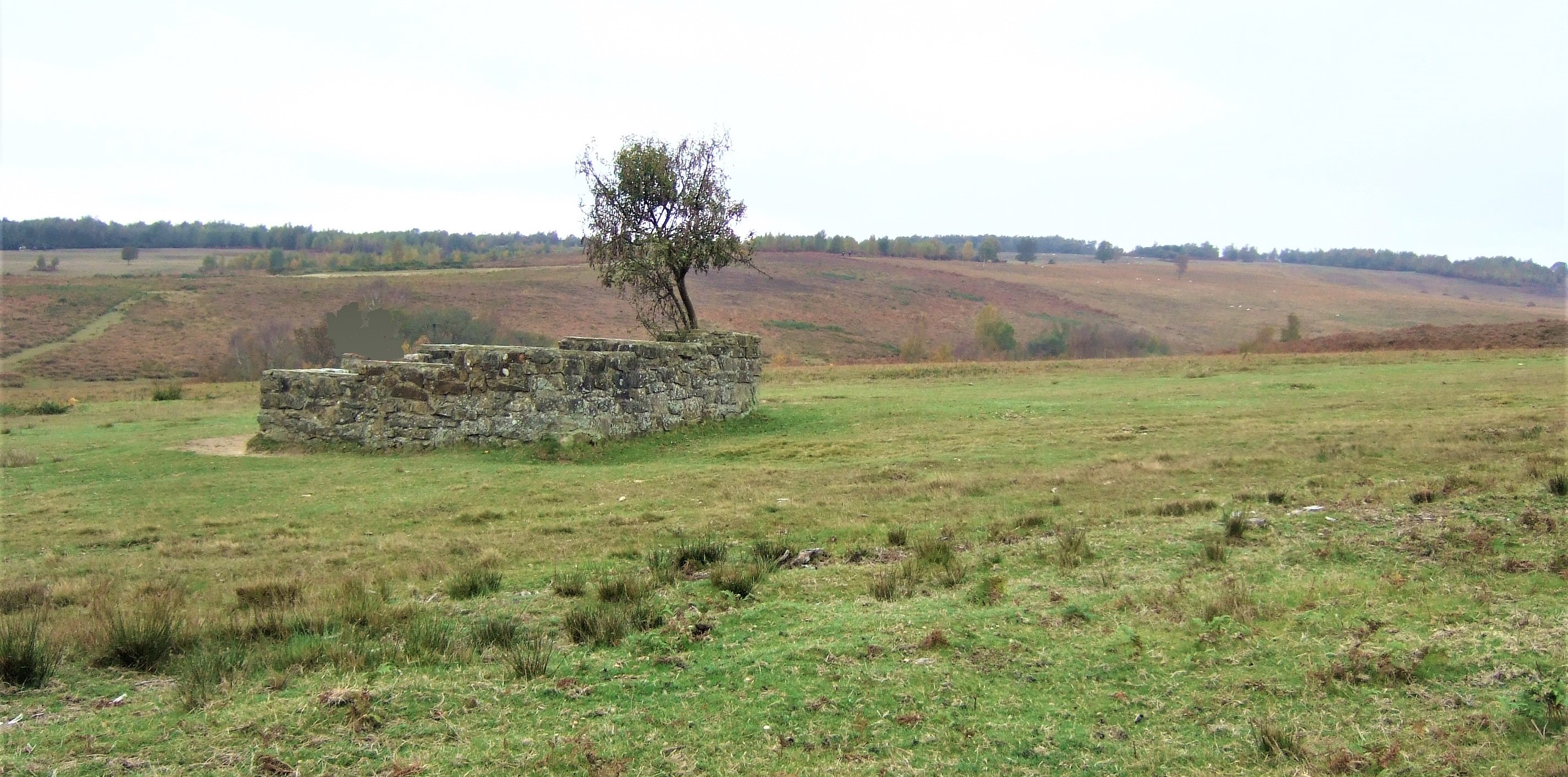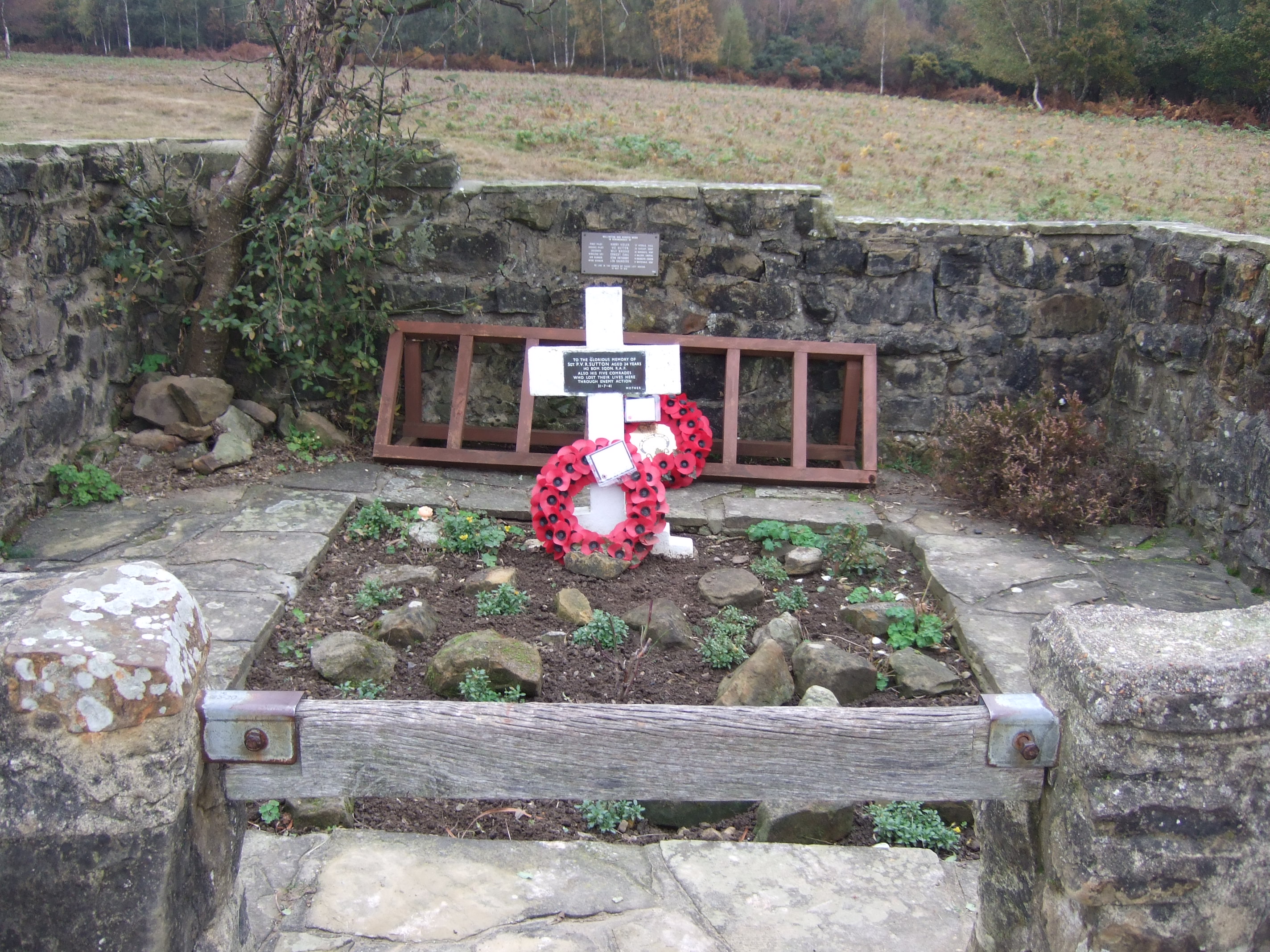The Crash of a Wellington Bomber on Ashdown Forest on 31 July 1941 and
the Airman's Grave

Flight Sergeant Harry Vidler (second left) and his crew at R.A.F. Binbrook
Image courtesy of Mrs Gill Vidler (click to enlarge)
During the Second World War a Wellington bomber captained by Flight Sergeant Harry Vidler crashed on the southern slopes of Ashdown Forest and burst into flames. All six aircrew were killed. The site of the crash, in an area of open heathland a mile east of Nutley, is now marked by a stone enclosure known as the Airman's Grave, which is actually a memorial that had its origins in a small wooden cross erected by the mother of the plane's second pilot soon after the crash.
The crash happened at 04:56 hours GMT (6.56pm local time — double British summertime was in operation) on the morning of Thursday, 31 July 1941. The twin-engined long-range bomber had taken off five hours previously with five other Wellingtons of No.142 Squadron from R.A.F. Binbrook in Lincolnshire. The aircraft were taking part in a night attack on Cologne's railway marshalling yards by a force of 116 bombers from Bomber Command. F/Sgt. Vidler's Wellington reached Cologne and dropped its bombs on target, but developed an engine fault and crashed on Ashdown Forest on return from Germany. The crash was attributed by the squadron's commanding officer, Wing Commander Rex Kippenberger, to "Very poor weather and a faulty port engine".
The average age of the aircrew was 24. They were: Flight Sergeant Harry Vidler, first pilot and captain, aged 27; Sergeant Vic Sutton, second pilot, 24; Sergeant Wilf Brooks, observer (navigator), 24; Flight Sergeant Ernest Cave, wireless operator/air gunner, 21; Sergeant Stan Hathaway, wireless operator/air gunner, 24; and Flight Sergeant Len Saunders, rear gunner, 21. Their names are commemorated on a plaque at the Airman's Grave, but they were interred (or cremated in the case of F/Sgt. Vidler) in their home towns: Hull, Lewisham, Ramsgate, Wallasey, Stockton-on-Tees, and Whitstable, respectively.
The photograph that appears at the top of this article shows Harry Vidler with his regular aircrew next to their Wellington at a snowy R.A.F. Binbrook in 1941. From left to right they are F/Sgt. Saunders, F/Sgt. Vidler, F/Sgt. Cave, Sgt. Morton Cohen, and Sgt. Brooks. Sgt. Cohen missed the final, fatal flight, possibly because he was about to leave the squadron for an overseas posting, and was replaced by Sgt. Hathaway, for whom this would be his first and sadly last operation.

The Airman's Grave on Ashdown Forest's Heathland
Click to enlarge
The Airman's Grave's originated with a small wooden cross that Mrs Elsie Sutton, the mother of second pilot, Sgt. Vic Sutton, erected at the site of the crash soon after it happened. Mrs Sutton dedicated the cross to the memory of her son and the rest of the aircrew. She was instrumental in the subsequent creation of the enclosure, initially a simple picket fence, that surrounds the cross. In due course the wooden cross was replaced by a stone cross, and in 1971 the enclosure's fence, by now made of wire mesh, was replaced by today's sandstone wall. In 1992, 51 years after the crash, a local retired airline pilot and former R.A.F. navigator, Frank Wilson, arranged for a plaque to be fixed to the sandstone wall which for the first time listed all the members of the Wellington's aircrew.
In recent years this simple, roughly built memorial has developed into the focal point for a moving Remembrance Sunday service attended by thousands of people.

The Interior of the Airman's Grave
Click to enlarge
In 2021 the Ashdown Forest Research Group was invited to carry out research into the aircrash by the chief executive of Ashdown Forest, the late James Adler, to mark the 80th anniversary of the tragedy. We have published three articles based on this research in Ashdown Forest News. These articles can be found on our publications page. We continue to welcome reliable eye-witness evidence concerning the crash and also (especially) information about how the crash site was dealt with and cleared afterwards. We also continue to welcome old photos of the crash site and the Airman's Grave. If you can help, please email us.
How to find the Airman's Grave
The Airman's Grave is situated in Sussex on the southern slopes of Ashdown Forest. It is in the lower Misbourne Valley, roughly midway on a horizontal line drawn between Nutley and Duddleswell, about 500m east of Lower
Misbourne Farm. The Sussex Diamond Way long-distance footpath passes less than 200 meters to the south-west of the memorial. The Ordnance Survey grid reference is TQ 45892 27612. The geographical co-ordinates are latitude: 51°1'46"N, longitude: 0°4'45"E.
Ashdown Forest Research Group © 2024